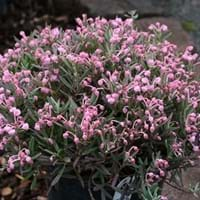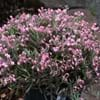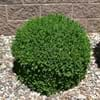Life Span
Annual and Perennial
Perennial
Type
Broadleaf Evergreen
Flowering Plants
Origin
North America, Europe, Asia
Italy, Southern Europe, western Balkans
Types
Andromeda polifolia var. polifolia, Andromeda polifolia var. glaucophylla
not available
Number of Varieties
Not Available
Habitat
Bog Garden, Fens, Swamps
Islands, Not Available
USDA Hardiness Zone
2-6
7-10
AHS Heat Zone
Not Available
7 - 4
Sunset Zone
Not Available
21,22
Habit
Cushion/Mound-forming
Upright/Erect
Flower Color
White, Pink, Light Pink
Lavender, Light Blue, White
Flower Color Modifier
Not Available
Bicolor
Fruit Color
Not Available
Non Fruiting Plant
Leaf Color in Spring
Gray Green
Green, Light Green
Leaf Color in Summer
Gray Green
Green, Light Green
Leaf Color in Fall
Gray Green
Green, Light Green
Leaf Color in Winter
Gray Green
Light Green
Leaf Shape
Long Linear
Compound
Plant Season
Spring, Summer, Fall, Winter
Summer, Fall
Sunlight
Full Sun, Partial Sun, Partial shade
Full Sun, Partial Sun
The pH of Soil
Acidic
Acidic, Neutral
Soil Drainage
Average
Average
Bloom Time
Late Spring, Early Summer
Early Summer, Summer, Late Summer
Tolerances
Not Available
Heat Tolerance
Where to Plant?
Container, Ground
Ground, Pot
How to Plant?
Seedlings
From bulbs, Seedlings, Stem Planting
Plant Maintenance
Medium
Low
Watering Requirements
Do not let dry out between waterings, Keep ground moist
Average Water Needs, Do Not over Water, Never Over-water, Requires regular watering
In Summer
Average Water, Ample Water
Lots of watering
In Spring
Ample Water
Moderate
In Winter
Not so frequently
Average Water
Soil pH
Acidic
Acidic, Neutral
Soil Drainage Capacity
Average
Average
Sun Exposure
Full Sun, Partial Sun, Partial shade
Full Sun, Partial Sun
Pruning
Prune for size control, Remove short twigs
Remove damaged leaves, Remove dead branches, Remove dead leaves, Remove dead or diseased plant parts
Fertilizers
fertilize in spring
fertilize every 2-3 weeks while growing, fertilize in growing season
Pests and Diseases
No serious insect or disease problems
fungus
Plant Tolerance
Not Available
Drought, Heat Tolerance
Flower Petal Number
Single
Single
Showy Foliage
No
Not Available
Foliage Texture
Fine
Not Available
Foliage Sheen
Matte
Not Available
Attracts
pollinators
Birds, Insects
Allergy
Not Available
Toxic
Aesthetic Uses
Showy Purposes
Beautification, Landscape Designing, Showy Purposes
Beauty Benefits
Not Available
Not Available
Environmental Uses
Not Available
Air purification
Medicinal Uses
Not Available
Asthma, Cough, Unknown
Part of Plant Used
Flowers
Flowers, Leaves
Other Uses
As a tea substitute
Decoration Purposes, Showy Purposes, Used as Ornamental plant
Used As Indoor Plant
No
Yes
Used As Outdoor Plant
Yes
Yes
Garden Design
Bog Garden, Container, Mixed Border, Rock Garden, Wall
Mixed Border, Wildflower
Botanical Name
ANDROMEDA polifolia
CAMPANULA pyramidalis
Common Name
Bog Rosemary
Chimney Bellflower
In Hindi
Bog Rosemary
Chimney Bellflower
In German
Rosmarinheide
Schornstein Glockenblume
In French
Andromeda polifolia
cheminée Bellflower
In Spanish
Andromeda polifolia
Chimenea Bellflower
In Greek
Bog Rosemary
καμινάδα καμπανούλα
In Portuguese
Bog Rosemary
chaminé Bellflower
In Polish
Modrzewnica zwyczajna
komin Bellflower
In Latin
Bog Rosemary
caminorum purgatores Bellflower
Phylum
Magnoliophyta
Tracheophyta
Class
Magnoliopsida
Magnoliopsida
Family
Ericaceae
Campanulaceae
Genus
Andromeda
Campanula
Clade
Angiosperms, Asterids, Eudicots
Angiosperms, Asterids, Eudicots
Tribe
Not Available
Not Available
Subfamily
Vaccinioideae
Not Available
Number of Species
Not Available
Properties of Bog Rosemary and Chimney Bellflower
Wondering what are the properties of Bog Rosemary and Chimney Bellflower? We provide you with everything About Bog Rosemary and Chimney Bellflower. Bog Rosemary doesn't have thorns and Chimney Bellflower doesn't have thorns. Also Bog Rosemary does not have fragrant flowers. Bog Rosemary has allergic reactions like Not Available and Chimney Bellflower has allergic reactions like Not Available. Compare all the properties and characteristics of these two plants. Find out which of these plant can be used as indoor plant. If you are interested to decorate your house and garden, find out aesthetic uses, compare them and select the plant which will beautify your surrounding. Along with beautification, try comparing medicinal and edible uses of Bog Rosemary and Chimney Bellflower and you can choose the plant having best and most benefits.
Season and Care of Bog Rosemary and Chimney Bellflower
Season and care of Bog Rosemary and Chimney Bellflower is important to know. While considering everything about Bog Rosemary and Chimney Bellflower Care, growing season is an essential factor. Bog Rosemary season is Spring, Summer, Fall and Winter and Chimney Bellflower season is Spring, Summer, Fall and Winter. The type of soil for Bog Rosemary is Loam and for Chimney Bellflower is Loam while the PH of soil for Bog Rosemary is Acidic and for Chimney Bellflower is Acidic, Neutral.
Bog Rosemary and Chimney Bellflower Physical Information
Bog Rosemary and Chimney Bellflower physical information is very important for comparison. Bog Rosemary height is 33.00 cm and width 46.00 cm whereas Chimney Bellflower height is 120.00 cm and width 45.70 cm. The color specification of Bog Rosemary and Chimney Bellflower are as follows:
Bog Rosemary flower color: White, Pink and Light Pink
Bog Rosemary leaf color: Gray Green
Chimney Bellflower flower color: Lavender, Light Blue and White
- Chimney Bellflower leaf color: Green and Light Green
Care of Bog Rosemary and Chimney Bellflower
Care of Bog Rosemary and Chimney Bellflower include pruning, fertilizers, watering etc. Bog Rosemary pruning is done Prune for size control and Remove short twigs and Chimney Bellflower pruning is done Remove damaged leaves, Remove dead branches, Remove dead leaves and Remove dead or diseased plant parts. In summer Bog Rosemary needs Average Water, Ample Water and in winter, it needs Not so frequently. Whereas, in summer Chimney Bellflower needs Lots of watering and in winter, it needs Average Water.




